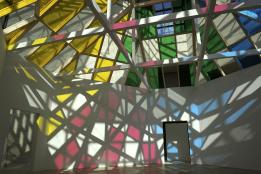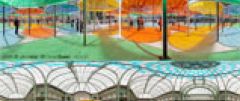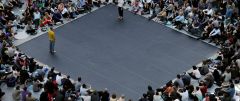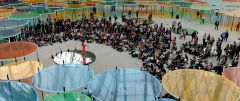© Daniel Buren / ADAGP, Paris.
Light
Light – decisive for perception – is an integral part of Daniel Buren’s work. Just as difficult to grasp and describe as colour, it plays with materials that are reflective, translucent or transparent, and with shapes and shadows, and indeed colours, ceaselessly transforming the work and its environment.
Obvious or subtle, configured in infinite ways, light is always part of the whole. This is hardly surprising for an artist who works in situ, since the lighting can radically alter our appreciation of a place.
Incidentally, in his work in institutions Daniel Buren has often drawn attention to the way museums handle light: stable artificial lighting instead of natural overhead lighting, poor use of skylights and light wells, lighting systems that manipulate the way the works are perceived.
Daniel Buren also uses artificial lighting, especially at night. So The Two Plateaux, in the main courtyard of the Palais-Royal in Paris, is quite a different spectacle at dusk when the lights come on. The work is open to a double interpretation: it has a diurnal and a nocturnal face, which once again shows how powerfully light influences our perception.
From the simplest arrangements (daylight), traditional and ancestral devices (Chinese lanterns, lamps, stained glass windows) to the latest technology (fibre optics), the sensation of light which changes the appearance of things and spaces is one of the fundamental elements in Daniel Buren’s work. Light crosses space, changes shape or colour, is harsh or subdued, natural or artificial, but it always acts strongly on the way we see things as the days and seasons pass.







 Photo-souvenir : « Architecture, contre-architecture : transposition » travail in situ, MUDAM, Luxembourg, 2010. Détail
Photo-souvenir : « Architecture, contre-architecture : transposition » travail in situ, MUDAM, Luxembourg, 2010. Détail